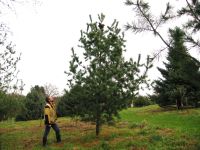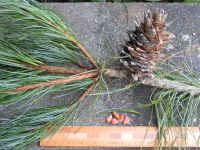Korean white pine - Pinus koraiensis
English name:
Korean white pine
Scientific name:
Pinus koraiensis
Family:
Pinaceae (Pine family)
Height:
up to 30 m.
Flowering:
Early summer
Range:
Manchuria, Russian Far East, Korea, Japan
 |
 |
The 23-year-old Pinus koraiensis in the picture can be found near the edge of a grass plain leading up to Cuckoo Hill: square 1802 position 1515.
Plant description:
Everyone would probably have a different idea of what should be included in their own private Garden of Eden. For me it must include plants that are a delight to the eye, the nose and that produce something tasty. No doubt my Garden of Eden would include at least one species of pine that produces edible seed. Pine nuts are not only delicious they are exceptionally nutritious. If stored in a dry, well-ventilated area, pine nuts can be kept for several years without spoiling. The pine I would choose would be the Korean white pine (Pinus koraiensis). It is hardy, the foliage is attractive, the cones are striking and the seed taste heavenly. I can well imagine an area with a light overstory of this pine with an understory of rhododendrons, blueberries and many other delightful things growing beneath.
The genus Pinus comprises about 110 species. Of these about 29 species produce seed that have been used as a source of food for man. Most species with edible seed belong to the subgenus haploxylon (for example P. koraiensis) and while a few are in the subgenus diploxylon (P. pinea for example). Pine seed are used locally and are sold in international trade. In Rotterdam, the Netherlands, about 100 tonnes of pine nuts are imported annually from China and Pakistan according to an FAO review. The most widely used nuts these days come from Pinus pinea, P. koraiensis and P. gerardiana. Of these three species only P. koraiensis can be reliably grown in Denmark. The Hørsholm Arboretums collection contains 5 different species of pines producing edible seed. There are 27 specimens of Pinus koraiensis. The wild collected specimens come from Manchuria and South Korea. The Manchurian trees appear to be healthier on average with denser crowns. But healthy trees are found from both countries. The oldest wild collected tree in the Hørsholm Arboretum is only 28 years old. Our oldest tree is a grafted specimen in the Forest Botanic Garden in Charlottenlund from 1890. This year this tree has produced abundant cones, but they are too high up to reach without considerable effort.
Pinus koraiensis was introduced in Britain about 1860 and is first reported in Denmark about 1890. Our oldest specimen is in the Forest Botanic Garden in Charlottenlund and thus is probably among the oldest in Denmark. Earlier workers at the Arboretum judged this specimen to be a possible hybrid. The species hybridizes with a number of other species but further studies are needed to clear this up.
Needles occur in bundles of 5. The edges of the needles are finely saw-toothed, which can be felt by running the fingers from the tip to the base of a needle. The two inner sides are bluish-white and the outer surface green. The needles in cross section have three resin canals (P. cembra has only two). The young shoots have dense brown hairs that distinguish it from the closely related P. armandii. The male strobili are reported to be crimson, which is rather unusual for a pine. The green maturing cones are striking with the free tips of the cone scales sticking out in all directions. This makes the cones appear to be well armed but they are not. However, they do ooze a considerable amount of pitch.
Pinus koraiensis is a slow growing tree making it suitable for the smaller garden and it is especially recommended for colder climates. Several named cultivars exist and these are reproduced by grafting. Trees grown from seed typically take 10 to 20 years to start producing their own seed.
References:
Ciesla, W. M. et al. 1998. Non-wood forest products from conifers. FAO - Food and Agriculture Organization of the United Nations (available on internet).
Farjon, A. 1984. Pines. Drawings and descriptions of the genus Pinus. E.J Brill /Dr. W. Backhuys, Leiden. 220 pp.
Lange, J. 1994. Kulturplanternes Indførselshistorie i Danmark. (Introduction History of Cultivated Plants in Denmark). Jordbrugsforlaget, Frederiksberg. 458 pp.
Poor, J.M. & Brewster, N.P. 1994. Plants that merit attention. I. Trees. Timber Press Inc. Portland.
Rushforth, K. 1999. Trees of Britain and Europe. Harper Collins Publisher, London. 1135 pp.
